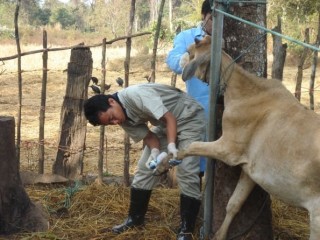 The United Nations’ Food and Agriculture Organisation (FAO) and the World Organisation for Animal Health (OIE) have announced plans to jointly combat foot-and-mouth disease on a global scale.
The United Nations’ Food and Agriculture Organisation (FAO) and the World Organisation for Animal Health (OIE) have announced plans to jointly combat foot-and-mouth disease on a global scale.
The two organisations are meeting in Bangkok this week and have laid out a detailed global strategy to bring the devastating livestock disease under control.
FAO regional representative for Asia and the Pacific Hiroyuki Konuma said recent FMD outbreaks around the world had demonstrated that animal diseases have no boundaries and can have a devastating impact.
The FAO said FMD presented a high burden to millions of farmers, pastoralists and commercial operators, caused lost trade opportunities and posed a hindrance to human development. Most importantly, for the poorest farmers who often depend on just a few animals, FMD meant hunger and economic ruin when it struck and cut off their only source of income and protein.
The two organisations have emphasised that the strategy can only work with solid commitments of support from global partners.
"One main objective of the Global Strategy is to allow FMD control worldwide through the strengthening of veterinary services responsible for animal disease control," explained Bernard Vallat, OIE Director General.
"Positive effects of the strategy will extend far beyond the control of FMD because it represents an opportunity to initiate long-term actions which will enhance veterinary services' capacity to fight other high-impact diseases of livestock. At the regional level the South-East Asia and China FMD campaign (SEACFMD) programme managed by OIE/Bangkok is considered as a very efficient model."
The FAO's chief veterinary officer Juan Lubroth said the successful eradication of rinderpest, which was a joint effort by scientists, governments, donors, veterinarians and farmers, clearly showed that major disease threats can be reduced and even eliminated.
"We could apply lessons learned and appropriate approaches when it comes to foot-and-mouth disease: better surveillance, coordination and control to reduce FMD outbreaks and finally eliminate the virus, to safeguard food security, animal health and human health," he said.
The Global Strategy combines two tools developed by FAO and the OIE.
The OIE tool, called the Performance of Veterinary Services Pathway (PVS), evaluates national veterinary services with the aim of bringing them into compliance with OIE quality standards.
Reliable veterinary services ensure the quality and safety of livestock production. In turn, strong veterinary systems protect the safety of food sources, trade and animal health, and as such, are a global public good.
FAO developed the Progressive Control Pathway for Foot-and-Mouth Disease, the PCP-FMD, which guides countries through a series of incremental steps to better manage FMD risks, beginning with active surveillance to establish what types of FMD virus strains are circulating in the country and neighbouring areas.
The process moves countries continuously towards improved levels of FMD control and thus an eventual opening to trade and international markets. A key pillar of the PCP-FMD involves coordinating efforts with countries in the same region in order to control the disease systematically across porous national boundaries.
The aim of the FMD Global Strategy is to decrease the impact of FMD worldwide by reducing the number of disease outbreaks in infected countries until they ultimately attain FMD-free status, as well as by maintaining the official FMD-free status of countries that are already free.
With many countries in the earliest stages of FMD control, the PCP-FMD benchmarks progress with the aim of eventually applying to the OIE for official recognition of their national control programmes and of their FMD-free status, with or without vaccination.
The FMD Global Strategy has been prepared by FAO and OIE under the umbrella of their Global Framework for the Progressive Control of Transboundary Animal Diseases (GF-TADs), in consultation with selected experts, countries and donors, as well as with regional and international organisations. Particular emphasis is put on regions of the world where the disease is endemic, including most of sub-Saharan Africa, the Middle East, and Asia.
The strategy contributes considerably to poverty reduction by increasing trade opportunities and contributing to and protecting the daily incomes of the one billion poor farmers worldwide who depend on livestock.
Losses in the billions
While FMD is seldom fatal, the disease can cause high mortality in newborn and young animals, weight loss, reduced milk yields and lower fertility. The global annual cost of FMD in terms of production losses and the need for prevention by vaccination has been estimated to be approximately $5 billion.
In a severe event in 2001 in the United Kingdom, the direct and indirect impacts are estimated to have cost as much as $30 billion.
Earlier outbreaks had similar tolls: in the Chinese province of Taiwan in 1997, a major epidemic cost the economy $15 billion, while Italy in 1993 suffered economic damages of $130 million.
